
Today, I love using wide angle lenses, but it took me several years to get to that point. As a Nikon photographer, I certainly wasn’t short on options; it’s just that none seemed to work quite right for my needs. If that sounds familiar – you’re constantly comparing wide angles – hopefully this article will help you make a decision.
Over the past few years, I’ve tried almost all of Nikon’s modern wide angle lenses, as well as a number of third-party options. Nasim has tested even more for our many reviews on Photography Life. The only consistent theme is compromise. No wide angle is truly perfect. However, they are getting better and better over time, and some of today’s options are pretty incredible.
This article ranks what I consider to be the top thirteen wide-angle lenses for Nikon full-frame cameras. (I’ve included a section at the bottom for Nikon DX shooters.) As you would expect, any list like this is bound by the author’s own preferences. If there were just one “best” wide angle for everyone, lens companies wouldn’t be making so many different options.
So, before anything else, here are the features I considered when ranking the lenses below, from most to least important to me:
- Overall image quality: From sharpness to distortion, everything comes down to image quality. A lens could excel by every other measure, but few photographers would buy it if it fails every optical test.
- Price/value: For most of us, a close second to image quality – and another potential dealbreaker – is simply the price (or, perhaps more accurately, the value) of the lens. Wide angles span a wide range of prices. The lenses below sell for $290 at the cheapest to $1900 at the most expensive.
- Size/weight: Wide angle lenses can get heavy. Some of them weigh just as much as telephotos, easily breaking the 1 kilo (2.2 pound) mark. For a lot of landscape and travel photographers, something lighter is just a necessity.
- Filter capability: Many wide angle lenses don’t have a screw-in filter slot at the front. In order to use filters with non-threaded lenses, you’ll need to buy a large, expensive adapter as well as larger, more expensive filters.
- Autofocus vs manual focus: Three of the thirteen lenses in the list below are manual focus only. That generally saves both money and weight, and manual focus isn’t the end of the world for a lot of wide angle shooters. That said, most photographers prefer the option of autofocus as well, all else equal.
- Focal length(s): I consider everything 24mm and wider to be “wide angle,” although all the lenses below go at least a bit wider than that. I’m awarding extra points to lenses that make it to 14mm or 15mm, as well as zooms with a greater-than-expected “telephoto” range.
- Maximum aperture: This feature only really matters for astrophotographers, but that is a significant subset of wide-angle shooters. Lenses with apertures of f/2.8 (or wider) can capture more light than f/4 lenses, resulting in a brighter, less noisy Milky Way.
Of the thirteen lenses below, I have personally used all but three – the Sigma 14-24mm f/2.8, Tokina 16-28mm f/2.8, and Nikon 18-35mm f/3.5-4.5 G. Nasim has used both the Tokina and the Nikon, which makes the Sigma 14-24mm f/2.8 the only lens on this list that we are relying on outside sources in order to rank.
Without further ado, let’s kick things off!
13. Zeiss Milvus 21mm f/2.8
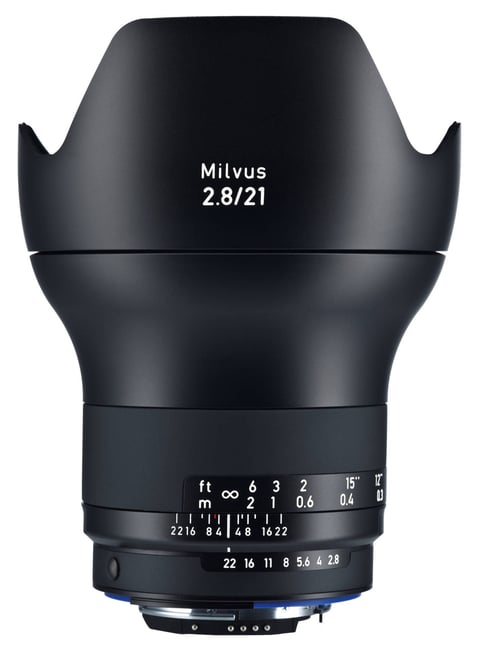
First up is the Zeiss Milvus 21mm f/2.8, an expensive manual focus prime lens with a small but dedicated following.
This lens has no real bells and whistles to speak of, and I’m sure a lot of photographers wonder if it lives up to the $1843 price tag in any way other than the “Zeiss” name.
To me, it does, although I admit that I would never buy this lens myself. Still, it is one of the sharpest wide angles I’ve ever tested, and it takes filters (82mm size) unlike many of the other lenses on this list.
I’m not one to write much about “intangible” aspects of a lens’s color rendition, rendering, or other qualities. With the right post-processing, I’ve never met a lens whose images can’t be finessed where I need them to go. That said, photos like the one below – which I took with the Milvus and didn’t post-process at all before exporting the RAW from Lightroom – sometimes do make me reconsider:

12. Samyang 14mm f/2.8
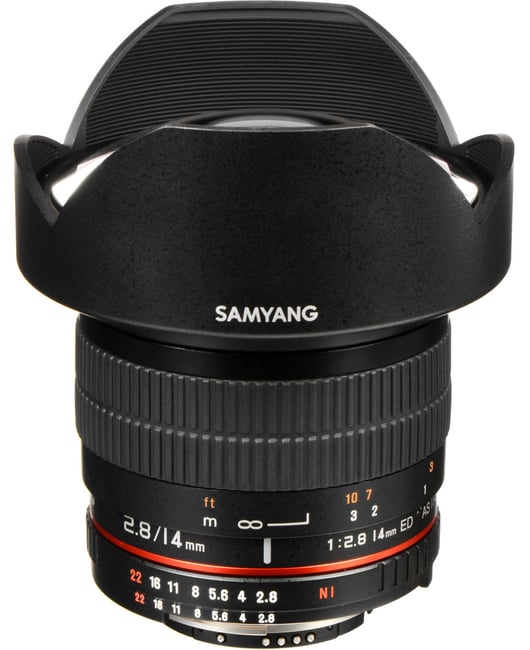
As the least expensive lens on this list, the bar for the manual-focus Samyang 14mm f/2.8 (sometimes branded as Rokinon or Bower) isn’t all that high. After all, it only costs $290 ($350 for the version with an AE chip).
Yet – while it’s true that image quality isn’t the reason you’d buy this lens – it holds its own, especially at smaller apertures. Even for Milky Way work, the Samyang has a good reputation, although I found it fairly lacking in that department (see my five-lens comparison here).
What the Samyang 14mm f/2.8 misses in image quality at f/2.8, it makes up for in size and price. If you want an inexpensive entry to the world of ultra-wides, you can’t do much better than this.
11. Sigma 14mm f/1.8 Art
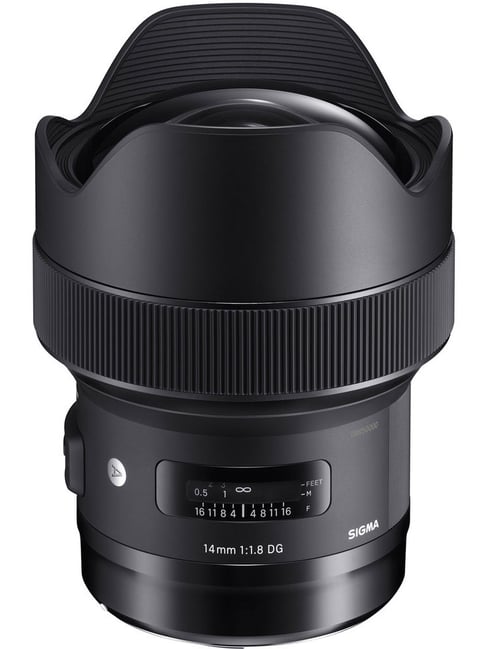
I only briefly used the Sigma 14mm f/1.8 A, but my impressions matched Nasim’s review: extremely heavy, expensive for Sigma ($1600) – and among best-in-class image quality.
That said, this is a highly specialized lens. It’s one of the priciest on this list, and, somehow, the heaviest of all thirteen lenses here. At 1170 grams (2.6 pounds), it will weigh you down in a hurry.
Not to mention that there are a number of other 14mm lenses on the market for Nikon, many of which (even the zooms) also have very good image quality. You’re paying a premium for some very special features with this lens (particularly the f/1.8 maximum aperture), so it’s worth making sure they matter. But if they do – you can’t beat the Sigma.

Image Copyright © Nasim Mansurov
10. Rokinon 14mm f/2.4
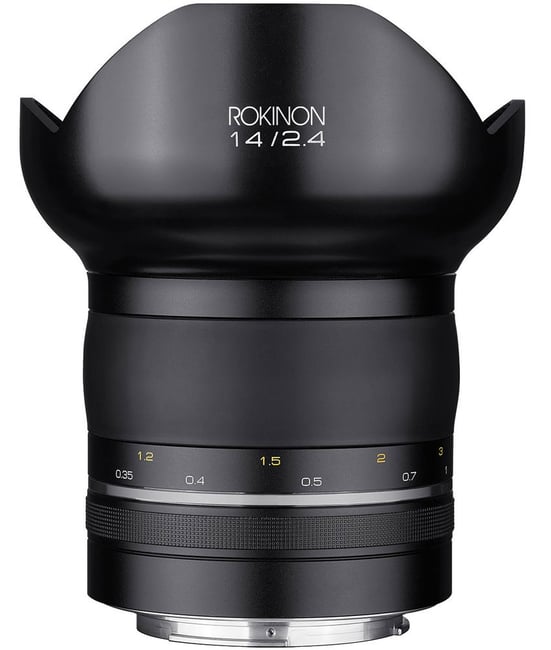
I put the little-known Rokinon 14mm f/2.4 lens ahead of the Sigma 14mm f/1.8 for a few reasons.
First, it is significantly lighter (719 vs 1170 grams) and half the price ($800 vs $1600). Those two facts alone make this a more palatable lens for a lot of photographers.
Second, the image quality of the Rokinon 14mm f/2.4 is extremely good. I didn’t have a chance to compare it directly to the Sigma 14mm f/1.8 when I used it, but I did compare its performance for Milky Way photography (arguably the most demanding possible application) against four other top 14mm lenses. It beat all of them, with practically no coma and impeccable sharpness even wide open.

Even aside from star photography, this is an excellent choice for shooting landscapes. It doesn’t have autofocus, but in terms of image quality, it’s either the best or second best lens on this list at 14mm. And again, the closest competition in that regard – the Sigma 14mm f/1.8 – costs twice as much.
The main downside is that it’s manual-focus only.

9. Nikon 16-35mm f/4

The first wide-angle zoom on this list is the Nikon 16-35mm f/4. It’s not a perfect lens by any means, and it has mixed reviews (though we liked it) – but it does the job in a lot of ways that more expensive lenses do not.
Case in point – it has autofocus, zoom, and even vibration reduction. The price is high, but not too high for what you get ($1100), and it’s on the lighter side for the lenses here (680 grams / 1.5 pounds). No, the 16-35mm f/4’s performance isn’t the best on the market, but it’s far from bad. This lens just makes sense for a lot of photographers, more so than most of the options here.

8. Nikon 18-35mm f/3.5-4.5
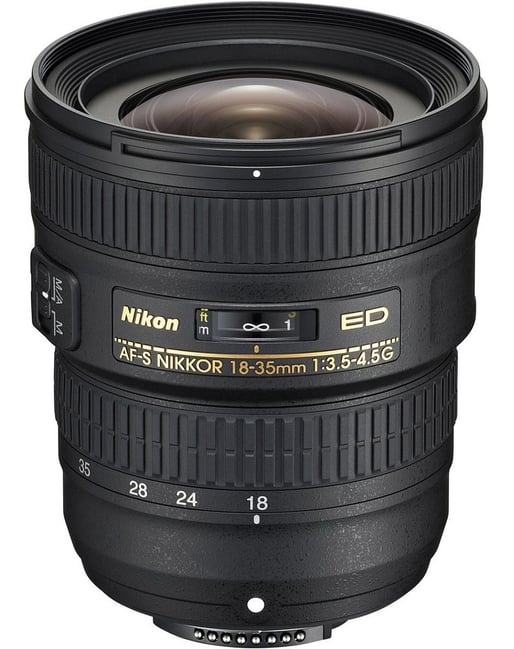
With similar image quality to the Nikon 16-35mm f/4 – but less weight and a significantly lower price – the Nikon 18-35mm f/3.5-4.5 G stands as one of the best bargain wide-angles you can get. It’s available for $750.
The 18-35mm f/3.5-4.5 G doesn’t go as wide as the other zooms on this list, and it also falls behind some of them in sharpness (especially corner sharpness at the longer focal lengths). I’ll also point out that the #9 lens above, the 16-35mm f/4, has vibration reduction, while this lens does not.
That said, you’re saving $350 with the 18-35mm f/3.5-4.5 G – or even more than that on the used market – and not missing out on any image quality to speak of. Indeed, our review demonstrates that the 18-35mm f/3.5-4.5 is actually a hair sharper than the 16-35mm f/4 overall, including in the corners.
So, for obvious reasons, this is one of the main lenses I recommend to photographers looking to buy their first wide-angle.

Image Copyright © Nasim Mansurov
7. Nikon 14-24mm f/2.8

One of the most famous wide angle lenses of all time is the Nikon 14-24mm f/2.8 – a lens that showed how good a modern ultra-wide can be (see our review).
Today, the 14-24mm f/2.8 is showing its age a bit, but that’s not surprising given that its release date was back in August of 2007.
The 14-24mm f/2.8 has excellent sharpness, almost no coma, and great image quality overall. For astrophotography, it’s hard to beat. This lens does suffer a bit from flare issues, and it’s a tad less sharp at 24mm than 14mm, but neither of those are major problems for most photographers. (In tricky cases with a lot of flare, you might consider our compositing trick in the field.)
Instead, the biggest issues with this lens are unrelated to image quality: weight, price, and lack of filter threads. Bought new, the 14-24mm f/2.8 is a whopping $1900 – though you can find it used and refurbished for much less. It also weighs 1000 grams / 2.2 pounds. That’s not the heaviest on this list (in fact, it’s fourth heaviest), but not exactly lightweight either.
If you do buy the 14-24mm f/2.8, I recommend going for one that’s used or refurbished. For the right price, it’s an excellent wide angle that’s as tried and true as they get.

6. Tamron 15-30mm f/2.8
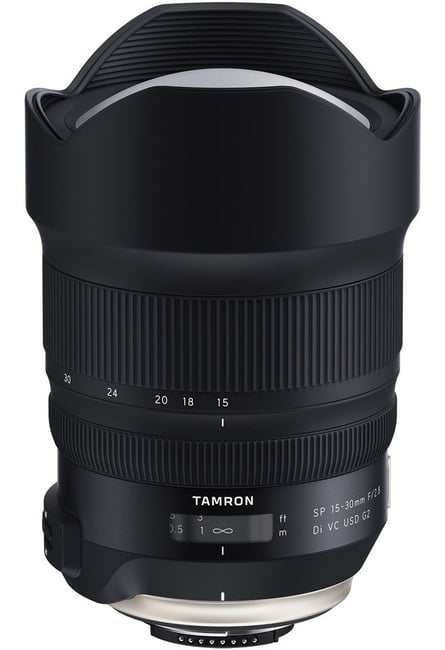
One of my favorite wide angle lenses I’ve used is the Tamron 15-30mm f/2.8. It’s a heavy lens, but it matches or even exceeds the Nikon 14-24mm f/2.8 in image quality overall – plus adds some modern features like vibration reduction and a water-repellant front element. Like the Nikon, it gets a bit weaker in the telephoto region (see our review), but even there it’s better than most.
The real reason to get this lens instead is the price. It sells for $1200 new and even less used – plus, there’s an older version with essentially identical image quality that sells for even better used prices.
The Tamron doesn’t go all the way out to 14mm (closer to 15.5mm instead). The boost to 30mm is nice, but I think that most of this lens’s potential users would care more about the wide end of things. Also, like the Nikon 14-24mm f/2.8, it doesn’t take filters natively, so you’ll need a fairly large and cumbersome attachment if that’s important to your photography.

5. Sigma 14-24mm f/2.8
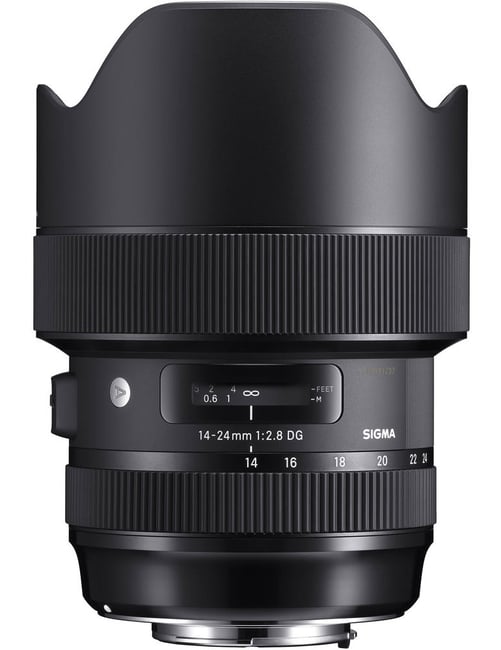
Next up is the Sigma 14-24mm f/2.8, which pulls ahead of the previous two f/2.8 zooms, though only by a hair.
The benefits? First – at $1200, the same cost as the Tamron above – the Sigma zooms out to 14mm rather than 15mm (which is really 15.5mm). That’s a relatively minor benefit for most photographers, but it’s enough to sway the rankings in Sigma’s direction when the lenses are all so close anyway.
Second, the Sigma is sharper than the #7 Nikon and #6 Tamron overall, especially at the longer end. (See Roger Cicala’s excellent review here for confirmation; this is the only lens on this list none of us at Photography Life have personally used.) In short, based on reviews like Roger’s and others, the Sigma 14-24mm f/2.8 has the best performance of any zoom on this list, or perhaps tied with that of the #2 lens below.
By comparison, the #6 Tamron’s benefits are that it has image stabilization and zooms to 30mm rather than 24mm. The #5 Nikon’s benefits are a slight weight reduction (1000 vs 1150 grams), and, as a name-brand lens, it may have better focusing compatibility on some cameras and perhaps better resale value in the future.
So, as you can see, it’s an extremely close race. If you want an f/2.8 wide-angle zoom, you can’t go wrong with any of the ones so far – or the next lens below.
4. Tokina Opera 16-28mm f/2.8

Winning the “f/2.8 zoom battle” is the Tokina Opera 16-28mm f/2.8. This lesser-known lens is a hidden gem; it has slightly weaker performance than the other three f/2.8 zooms above, but it pulls ahead in this comparison because of its excellent value.
Specifically – the Tokina costs a mere $700. That’s pretty insane for an f/2.8 wide angle zoom, making it arguably the best value of any lens on this list.
Like the other f/2.8 zooms above, the 16-28mm doesn’t have native filter capabilities, and it’s fairly heavy (though a tad lighter than the others at 940 g / 2.1 lbs). It’s a bit behind in f/2.8 sharpness versus the three zooms above, but it catches up at f/5.6 and beyond.
For dedicated astrophotography, I probably wouldn’t get this lens. But for more typical wide-angle photography – with a splash of Milky Way or Northern Lights from time to time – you can’t go wrong. Honestly, it beats me why this one has flown so far under the radar. See our review of the optically similar older version here.

Image Copyright © Nasim Mansurov
3. Tamron 17-35mm f/2.8-4

This lens is a new addition to our list (and you’ll notice some people in the comments section wonder why I didn’t include it). I just recently had a chance to test the Tamron 17-35mm f/2.8-4 extensively, and I found it to be an excellent lens.
First, the price is fantastic at $600, and it has very good image quality as well. It doesn’t weigh much, and goes to f/2.8 at the widest – great for astrophotography. All of this combines to make a very impressive package.
In fact, the Tamron 17-35mm f/2.8-4 doesn’t have many downsides to speak of, although corner sharpness isn’t quite at the level of a few other lenses on this list. That’s hardly a knock against this lens, though. If you need a wide-angle zoom for Nikon, it’s one of the first I’d consider.

2. Nikon Z 14-30mm f/4
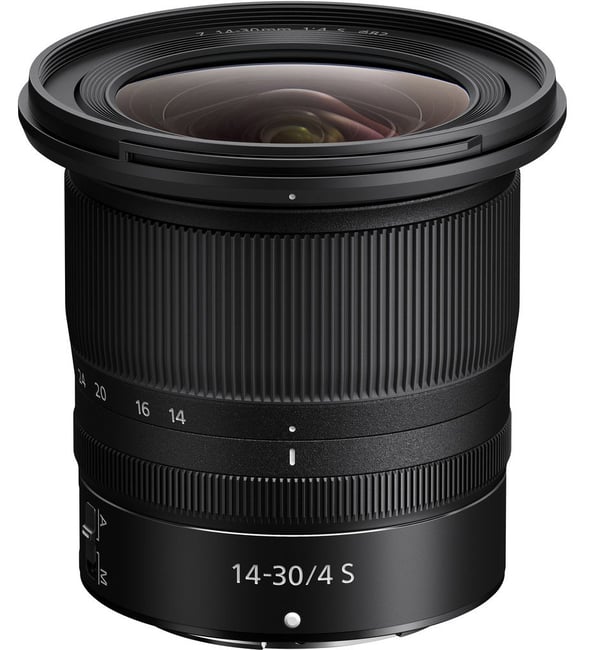
I don’t know if a Z-system-only lens is a fair inclusion in this article, but the list includes thirteen lenses total – so you can eliminate this one and still get more than a “top ten” comparison anyway :)
If you’re willing to count it, the $1300 Nikon Z 14-30mm f/4 is a fantastic lens. I’d even argue that it’s the best wide angle zoom currently available for Nikon cameras, though it’s a close race.
The 14-30mm f/4 is also a very polarizing lens. When I reviewed it earlier this year, I tested one great copy and one that was obviously decentered. Other photographers online have also mentioned that they noticed decentering issues on this lens.

However, I have since tested two more copies of the 14-30mm f/4, and both of them were exceptionally sharp. That makes one bad copy out of four, which is starting to look less like a pattern and more like bad luck the first time. (The bad copy was so bad that it was obvious; if yours is the same way, you’ll be able to tell pretty easily using our decentering testing method and can always return it.)
What’s so good about this lens? Excellent image quality – beating the Nikon 14-24mm f/2.8 head to head overall, with a tad less sharpness at 14mm and significantly more at 24mm. On top of that, it has less flare than any of the f/2.8 zooms listed above, which makes it great for backlit landscapes.
In terms of construction, at a mere 485 grams / 1.1 pounds, the 14-30mm f/4 is about half the weight of the f/2.8 zooms above. It also natively takes filters – the only 14mm lens listed here to do so (and, indeed, the world’s first 14mm lens to take front filters at all). These considerations are what vaults it to second place overall in this ranking.

One issue with the Nikon Z 14-30mm f/4 is its extremely high level of distortion. It also has a decent bit of vignetting. Nikon apparently made those design compromises knowing that distortion and vignetting are (fairly) easy to correct in post-processing software – and, indeed, you can’t even uncorrect photos from this lens in Lightroom at all.
On the bright side, all the good things I’m saying about this lens hold true regardless of the profile; it’s extremely sharp, and you do get the full 14mm even with corrections on (corrections off is more like 13.5mm – assuming your software even lets you view images with corrections off). Again, I went through all this in our review, so check it out if you haven’t yet.
Other than that, the biggest downside is the $1300 price ($100 more than the Sigma and Tamron zooms above). Combined with its optical quirks, the 14-30mm f/4 is not the perfect lens, and not the lens for everyone. Still, you can’t argue with the results, and this lens is in the top tier of image quality. If you’re a Nikon mirrorless shooter, it’s hard to prevent it from at least catching your eye.

1. Nikon 20mm f/1.8
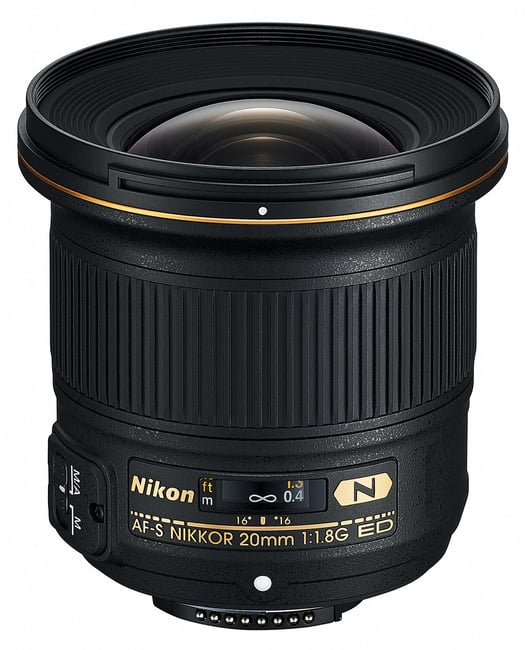
The top lens on this list – and, in my opinion, the best wide angle lens for Nikon cameras at the moment – is the Nikon 20mm f/1.8. See our review.
The only real downside with this lens is that it’s a 20mm prime. If you need wider than that, or if a zoom is critical to your photography, it’s probably not even on your radar. Other than that, I’m hard-pressed to find anything I don’t like about the 20mm f/1.8.
For starters, it’s sharp – more than any of the zooms on this list at 20mm, except maybe the 14-30mm f/4. And, with its f/1.8 aperture, it’s better than almost every lens above for astrophotography (assuming you don’t need the 14mm focal length for your Milky Way work).
The 20mm f/1.8 also has a filter ring (77mm) and weighs just 355 grams (12.6 ounces). And – perhaps the biggest benefit of all, in my opinion – it costs $800 new. Used, it routinely sells for less than $600 on eBay and Fredmiranda.
No lens is perfect, and primes aren’t for everyone. But if the 20mm focal length works for you, it’s hard to do much better than this.
The Lenses I Missed
With only thirteen lenses, the list above certainly doesn’t cover all the wide angles available today. Heck, there’s a case to be made that the single best wide-angle Nikon lens of all is the 19mm f/4 tilt-shift – though I didn’t include it above because, at $3400, it would stick out from all the others like a sore Otus.
More to the point, if your favorite lens isn’t listed above, that doesn’t make it a bad lens. I didn’t include some highly specialized lenses in the list above, nor any of an almost endless trove of older wide angle lenses available today. And if your ranking of important features is different from mine at the beginning of the article, your personal list could look wildly different.
That said, if you think there’s a good case for a lens I missed above, feel free to mention it in the comments section so other readers can hear about it! Perhaps I overlooked it, or perhaps it just barely didn’t make the list. (Certainly the #13 pick above, the Zeiss Milvus 21mm f/2.8, is a high bar to clear.)
In the comments section, I’ve seen a few people mention the Sigma 12-24mm f/4, Irix 11mm f/4, Nikon 17-35mm f/2.8, and the autofocus Samyang 14mm f/2.8. For various reasons, these lenses did not quite make this list, but each one has its own merits and could be what works best for your needs. This just emphasizes how many good wide-angles there are today, and how important it is to pick one that matches your specific requirements!
Wide Angle Lenses for Nikon DX
I mentioned in the introduction that this article only covers full-frame lenses for Nikon, but there are plenty of DX options as well with pros and cons of their own.
Without getting into all of them, the two that I recommend the most are as follows:
- Nikon AF-P 10-20mm f/4.5-5.6 – an ultralight, inexpensive, fast-focusing zoom that should be on every Nikon DX shooter’s shortlist. $310.
- Tokina 11-20mm f/2.8 – a bit larger and more expensive, but goes to f/2.8. If you want the option to do Milky Way or Northern Lights photography with a DX camera, this is the lens I’d get. $470.
There are quite a number of wide angle DX lenses, though, from several different manufacturers. If you find a good deal on something else, go for it.
Conclusion
When I’m deciding on a new lens, the hardest part is searching through the sheer number of options and trying to find a winner. With wide angles, it’s even harder than normal, because they all have compromises – even the best ones.
Hopefully, though, this list made things a bit easier for you. All the lenses above are excellent choices, and you really can’t go wrong with any of them (or a number of others that didn’t quite make the list). Above anything else, just pick one that intersects with your requirements, and don’t look back. The grass always seems greener, but at the end of the day, all of these lenses can be used to capture equally amazing photos.


Thanks for the comparison. I’m not sure, but it seems that most of these lenses are F mount. How many photographers are looking to purchase a new F mount lens at this point. Perhaps you could have divided the article into F mount and mirrorless. Also, there was nothing here about the excellent Nikkor 20mmf/1.8 Z lens. Finally, no love for anything wider than 14mm. There are plenty of folks looking for superwide.
Yeah, I wrote this article back in 2019 before most Z lenses existed. It would look pretty different today – I’ll go back and rewrite it as soon as possible.
I am after Nikkor 18-35D for DX ,can someone through light its pros and cons , thanks.
Hi,
Can we have an update on this page with the new lenses now available.
I purchased the AF-P Nikkor 10-20mm f/4.5-5.6. I liked everything about it except that it’s glacially slow. I do a lot of indoor photography in places where I can’t use a flash, like churches. I ended up selling it and getting the Tokina 11-20 for the extra stop and a half of speed. It’s one of my favorite lenses.
Which camera you used with AF-P Nikkor10-20mm f/4.5-5.6.?
Disappointed prime wides not discussed for nikon DX, only zooms.😪
I’m confused: is there such an animal? The only wide dx primes I’m aware of are a 10mm Samyang and a 16mm Rokinon – certainly not enough to warrant a “discussion.” Anything else you see in that range is a zoom or a fisheye
Nikon 10.5mm dx
I wouldn’t recommend that one unless you’re in need of a fisheye lens.
Of course all attributes of any lens are subjective, some features being more or less important due to individual needs but price should NEVER be used to rate a lens, only to make a buying decision. It has absolutely no effect on performance and could give the false impression that a cheaper lens is objectively better than a more expensive option.
I have the Nikon 20mm f1.8g for landscapes and astrophotography. It’s excellent value, sharp as a tack. Needs stopping down to f2.5 or f2.8 for astro to reduce vignette and coma if you’re a pixel peeper. I have the Tamron 17-35 f2.8-4 OSD too, very sharp, but prefer the ‘feel’ of the image colour and contrast of the Nikon 20
I am missing the manual focus Samyang XP 10mm F3.5. As a fulltime professional user I have to admit it’s not a lens for everyone but it’s the sharpest and widest rectilinear lens available for Nikon F with almost zero distortion, which is a prime feature they advertise with. Yes, there’s one lens that’s even wider, the Sigma 8-16mm f/4.5-5.6, but that’s delivering nowhere near the image quality of this Samyang.
On my Z6II with FTZ 10mm translates into an unworldly 122 degree field of view… but at € 1.149,00 it’s not cheap.
Though I haven’t made comparisons with other lenses, I really enjoy my Sigma 10-20mm f3.5 on my DX bodies (D3100 and now Z50)
Nikkor 17 35 mm f2.8 is awesome lens . Be it sharpness or detailing or image quality. It’s awesome and it gives the apparture 2.8 at max. It’s a hidden gem.